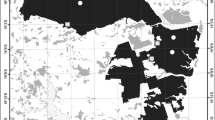Abstract
The aim of the study was to describe microclimate (surface and air temperature, humidity, light and wind intensity) and vegetation structure (density and height of reeds, and reed shoot structure) across the first 20 m of a sharp reedbed edge at Lake Velence, Hungary, in June 1996. There was a significant edge effect, although different variables contributed differently to the pattern. The reedbed edge had three bands: the first is characterised by very dense stand, where the shoots were thin and short; in the second band density declined, but reed shoots were thick and very high, and in the third band both density and height declined, but not shoot diameter. Microclimate variables showed similar pattern: reedbed edges were warm, dry, bright and windy, further inside temperature, light and wind intensity declined, humidity increased, and still further temperature and light intensity increased, and humidity decreased. I estimated that the edge effect penetrates into the reedbed up to ca. 15 m. The great variation of variables across the edge inevitable has significant impact on the occurrence of animals species; our knowledge, however, is too limited to predict the expected extinction of species owing to edge effect.
Similar content being viewed by others
References
Báldi A and Kisbenedek T (1998) Factors influencing the occurrence of Great White Egret (Egretta alba), Mallard (Anas platyrhynchos), Marsh Harrier (Circus aeruginosus), and Coot (Fulica atra) in the reed archipelago of Lake Velence, Hungary. Ekológia (Bratislava) 17: 384–390
Báldi A and Kisbenedek T (1999) Species-specific distribution of reed-nesting passerine birds across reedbed edges: effects of spatial scale and edge type. Acta Zoologica Academiae Scientiarum Hungaricae 45: 97–114
Brothers TS (1993) Fragmentation and edge effect in central Indiana old-growth forests. Natural Areas Journal 13: 268–275
Casenave JL, de Pelotto JP and Protomastro J (1995) Edge-interior differences in vegetation structure and composition in a Chaco semi-arid forest, Argentina. Forest Ecology and Management 72: 61–69
Chen J, Franklin JF and Spies TA (1992) Vegetation response to edge environments in old-growth douglas-fir forests. Ecological Applications 2: 387–396
Chen J, Franklin JF and Spies TA (1995) Growing-season microclimatic gradients from clearcut edges into old-growth douglas-fir forests. Ecological Applications 5: 74–86
Chvála M, Doskocil J, Mook JH and Pokorny V (1974) The genus Lipara Meigen (Diptera, Chloropidae), systematics, morphology, behaviour, and ecology. Tijdschrift voor Entomologie 117: 1–25
Cowie NR, Sutherland WJ, Ditlhogo MKM and James R (1992) The effect of conservation management of reed beds. II. The flora and litter disappearance. Journal of Applied Ecology 29: 277–284
Ditlhogo MKM, James R, Laurence BR and Sutherland WJ (1992) The effect of conservation management of reed beds. I. The invertebrates. Journal of Applied Ecology 29: 265–276
Dykyjová D (1971) Production, vertical structure and light profiles in littoral stands of reedbed species. Hidrobiologia 12: 361–376
Gryseels M (1989) Nature management experiments in a derelict reedmarsh. I: effect of winter cutting. Biological Conservation 47: 171–193
Hawke CJ and José PV (1996) Reedbed Management for Commercial and Wildlife Interest. RSPB, Sandy, Beds, UK
Jose S, Gillespie AR, George SJ and Kumar BM (1996) Vegetation responses along edge-to-interior gradients in a high altitude tropical forest in peninsular India. Forest Ecology and Management 87: 51–62
Matlack GR (1993) Microenvironment variation within and among forest edge sites in the Eastern United States. Biological Conservation 66: 185–194
Meffe GK and Carroll CR (1994) Principles of Conservation Biology. Sinauer Associates, Sunderland, MA, USA
Moskát C and Báldi A (1999) The importance of edge effect in line transect censuses applied in marshland habitats. Ornis Fennica 76: 33–40
Murcia C (1995) Edge effects in fragmented forests: implications for conservation. Trends in Ecology and Evolution 10: 58–62
Norusis MJ (1990) SPSS/PC+ for the IBM PC/XT/AT and PS/2. SPSS Incorporation, Chicago, IL, USA
Paton PWC (1994) The effect of edge on avian nest success: how strong is the evidence? Conservation Biology 8: 17–26
Skuhravy V (1981) Invertebrates and Vertebrates Attacking Common Reed Stands (Phragmites communis) in Czechoslovakia. Academia, Praha
Sokal RR and Rohlf FJ (1981) Biometry. WH Freeman and Company, New York, USA
Tscharntke T (1989) Attack by a stem-boring moth increases susceptibility of Phragmites australis to gall-making by a midge: mechanisms and effects on midge population dynamics. Oikos 55: 93–100
Tscharntke T (1992a) Cascade effects among four trophic levels: bird predation on galls affects densitydependent parasitism. Ecology 73: 1689–1698
Tscharntke T (1992b) Fragmentation of Phragmites habitats, minimum viable population size, habitat suitability, and local extinction of moths, midges, flies, aphids, and birds. Conservation Biology 6: 530–536
Young A and Mitchell N (1994) Microclimate and vegetation edge effects in a fragmented podocarp- broadleaf forest in New Zealand. Biological Conservation 67: 63–72
Van der Putten WH (1994) Assessing ecological change in European wetlands: how to know what parameters should be monitored to evaluate the die-back of common reed (Phragmites australis)? In: Aubrecht G, Dick G and Prentice C (eds) Monitoring of Ecological Change in Wetlands of Middle Europe, pp 61–68, Proceedings of the International Workshop, Linz, Austria, 1993. Stapfia 31, Linz, Austria and IWRB Publication No. 30, Slimbridge, UK
Vásárhelyi T, ed. (1995) Animal World of Reed Belt in Hungary. Hungarian Natural History Museum, Budapest, Hungary
Williams M, ed. (1993)Wetlands: A Threatened Landscape. Blackwell Publishers, Oxford, UK
Author information
Authors and Affiliations
Rights and permissions
About this article
Cite this article
Báldi, A. Microclimate and vegetation edge effects in a reedbed in Hungary. Biodiversity and Conservation 8, 1697–1706 (1999). https://doi.org/10.1023/A:1008901514944
Issue Date:
DOI: https://doi.org/10.1023/A:1008901514944




